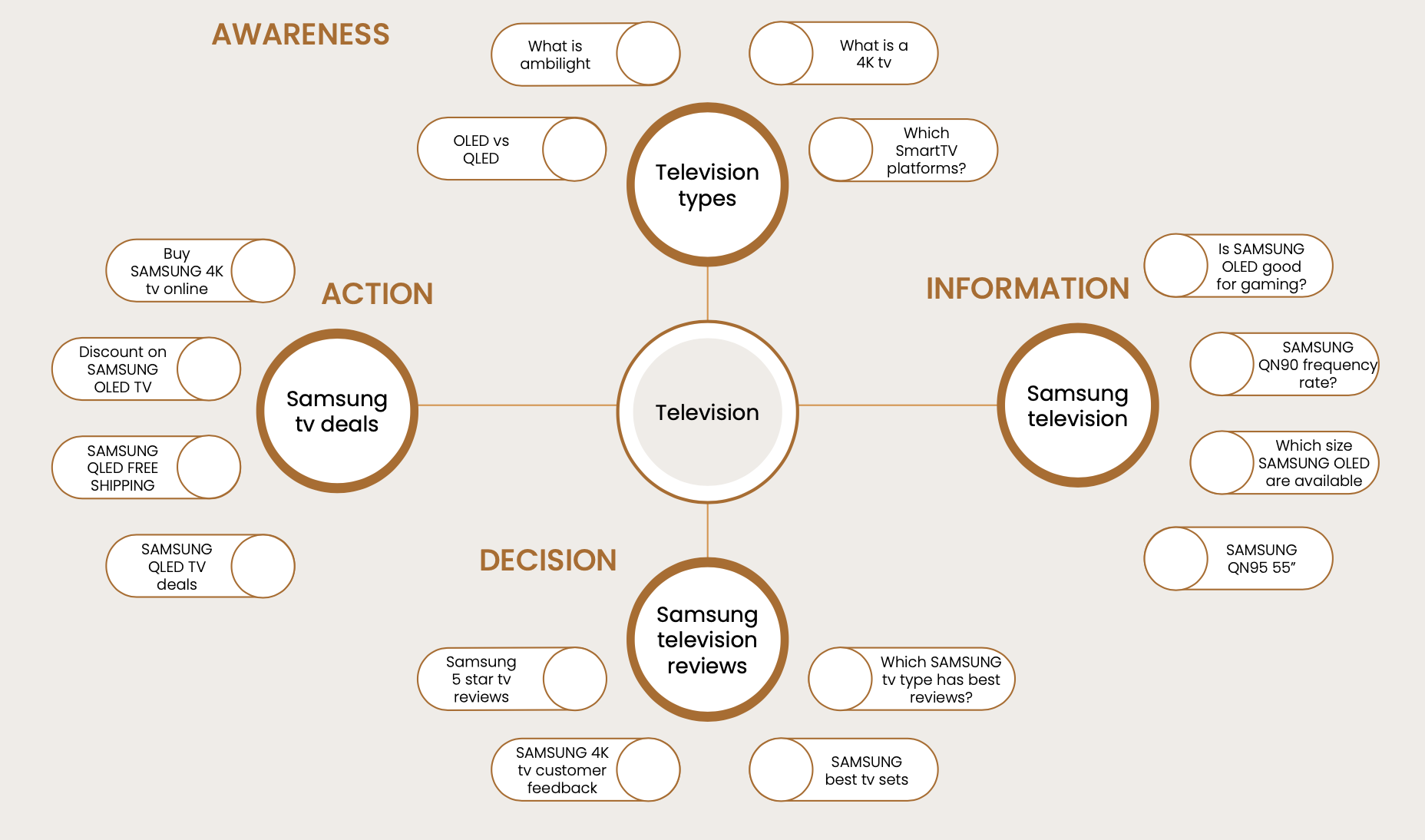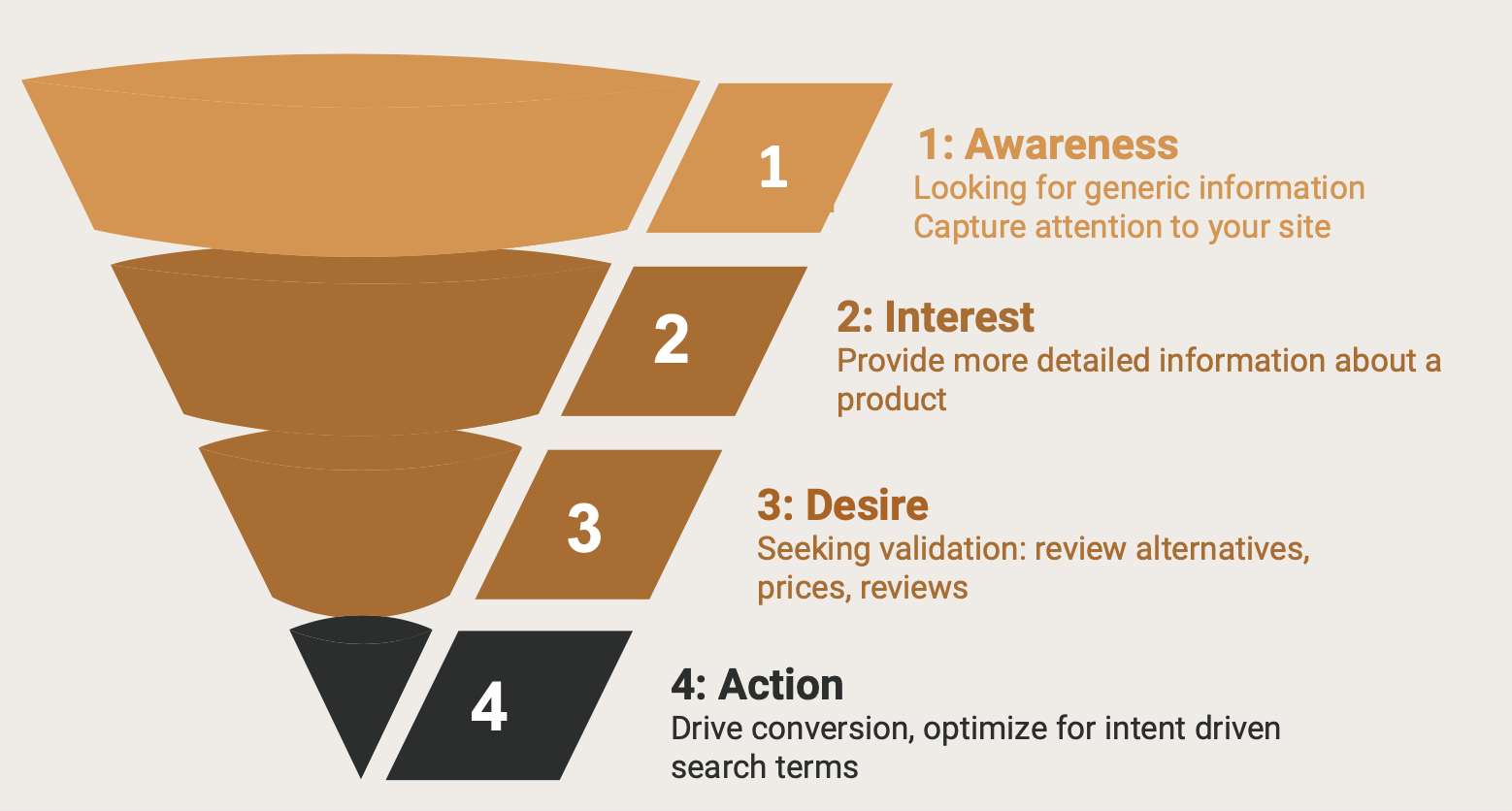
In the dynamic world of e-commerce, staying ahead of the competition requires more than just a great webshop and quality products—it demands a thoroughly optimized webshop for search engines. However, optimizing a webshop for search engines entails more than just targeting (a lot of) specific keywords. It requires a deep understanding of customer intent and creation of tailored content that resonates with their queries.
With users having various search intentions (read more about Search Intent in our other blog: Understanding Search Intent: Enhancing Your SEO Strategy), optimizing for diverse intents can be challenging and time-consuming, especially for non-enterprise level online retailers with limited resources.
This disparity in optimization efforts often puts them at a disadvantage compared to enterprise e-commerce webshops and digital marketplaces.
This is where Programmatic SEO can help. Programmatic SEO is an innovative approach that harnesses GenAI and automation to drive targeted traffic to your webshop with limited to no efforts. But how do you strike a balance between optimizing for a wide array of keywords while ensuring high-quality content that enhances user experience by aligning with search intent? The answer lies in aligning your programmatic SEO strategy with the SEO funnel. Let’s delve into the SEO funnel stages—Awareness, Interest, Desire, and Action—and explore how Programmatic SEO can serve as your secret weapon for success.
What is the AIDA SEO Funnel?
AIDA stands for Awareness, Interest, Desire, and Action—a classic marketing model that outlines the stages a consumer goes through before making a purchase decision. Applied to SEO, the AIDA funnel represents the user’s journey from discovering a product or service to taking action, such as making a purchase.
Each stage of the AIDA funnel corresponds to different user intents when they perform a search:
Awareness Stage: At this phase, users demonstrate Informational Intent, seeking insights or solutions to their queries. They may utilize broad search terms or pose questions to search engines.
Interest Stage: Reflecting Navigational Intent, users endeavor to locate specific websites or brands. They might employ branded keywords or conduct searches for particular products or services.
Desire Stage: Customers seek validation, exploring reviews, alternatives, and prices to inform their decision-making process.
Action Stage: Entailing Transactional Intent, users display readiness to purchase. Their queries often contain keywords signaling purchase intent, such as “buy,” “order,” or “price.”

How Programmatic SEO Drives Revenue through the SEO Funnel
Programmatic SEO, powered by advanced algorithms and automation, plays a crucial role in guiding users through the SEO funnel:
Discover: Uncover Valuable Insights
The first step in leveraging AI-driven programmatic SEO is to discover valuable insights about your webshop and trends in the market. The data gathered (webshop data and setup, user behavior, industry trends etc.) during this process forms the basis of automated optimization of your webshop.
Enhance: Create powerful search terms with GenAI
During the second step, we utilize our cutting-edge GenAI technology to enhance and combine the results of the first step, Discover. Next to identifying semantic variations and combining these findings with for example facet filters, Aloome’s platform also takes into account the SEO Funnel stages and generates powerful search terms for each stage. Based on these new search terms, the platform generates tailored landing pages optimized for search engines.
Attract: Target relevant traffic based on search intent
The newly generated landing pages precisely target your audience’s search queries, taking into account the search intent of your users. By targeting these relevant keywords, we give searching customers a great user experience, as we offer them exactly the content and information they were looking for.
Optimize: Grow your organic search traffic and revenue
By continuous optimization of your targeted keywords, content, and automatic maintenance of the created landing pages, we ensure that our platform works tirelessly to attract more visitors and drive conversions through guiding users through the different stages of the funnel. You will also get invaluable insights into how much traffic is generated per funnel stage and how well search terms perform.
Do you want to read more about Programmatic SEO? Read our blog Revolutionize Your E-Commerce Strategy with AI-Driven Programmatic SEO about this topic.
Conclusion
Incorporating Programmatic SEO into your e-commerce strategy can significantly drive your organic revenue by effectively guiding users through the SEO funnel. By understanding user intent and optimizing your webshop accordingly, you can attract more visitors, engage them at every stage of their journey, and ultimately convert them into loyal customers. Programmatic SEO can help online retailers to optimize their webshop for the different SEO Funnel stages with limited effort.
With users having various search intentions (read more about Search Intent in our other blog: Understanding Search Intent: Enhancing Your SEO Strategy), optimizing for diverse intents can be challenging and time-consuming, especially for non-enterprise level online retailers with limited resources.
This disparity in optimization efforts often puts them at a disadvantage compared to enterprise e-commerce webshops and digital marketplaces.
This is where Programmatic SEO can help. Programmatic SEO is an innovative approach that harnesses GenAI and automation to drive targeted traffic to your webshop with limited to no efforts. But how do you strike a balance between optimizing for a wide array of keywords while ensuring high-quality content that enhances user experience by aligning with search intent? The answer lies in aligning your programmatic SEO strategy with the SEO funnel. Let’s delve into the SEO funnel stages—Awareness, Interest, Desire, and Action—and explore how Programmatic SEO can serve as your secret weapon for success.
What is the AIDA SEO Funnel?
AIDA stands for Awareness, Interest, Desire, and Action—a classic marketing model that outlines the stages a consumer goes through before making a purchase decision. Applied to SEO, the AIDA funnel represents the user’s journey from discovering a product or service to taking action, such as making a purchase.
- Awareness: At the top of the funnel lies Awareness, where potential customers become aware of their needs or challenges. They turn to search engines with broad queries, seeking information or solutions to their problems.
- Interest: As users progress down the funnel, their Interest is piqued as they delve deeper into research. They explore different options, compare products, and seek out reviews and recommendations to narrow down their choices.
- Desire: With a clearer understanding of their options, users enter the Desire stage, where they develop a strong inclination towards a particular product or solution. They may seek validation through testimonials, case studies, or product demonstrations.
- Action: The final stage of the funnel is Action, where users are ready to convert. Whether it’s making a purchase, signing up for a newsletter, or engaging with your brand in some way, this is the moment of decision and action.

Each stage of the AIDA funnel corresponds to different user intents when they perform a search:
Awareness Stage: At this phase, users demonstrate Informational Intent, seeking insights or solutions to their queries. They may utilize broad search terms or pose questions to search engines.
Interest Stage: Reflecting Navigational Intent, users endeavor to locate specific websites or brands. They might employ branded keywords or conduct searches for particular products or services.
Desire Stage: Customers seek validation, exploring reviews, alternatives, and prices to inform their decision-making process.
Action Stage: Entailing Transactional Intent, users display readiness to purchase. Their queries often contain keywords signaling purchase intent, such as “buy,” “order,” or “price.”

How Programmatic SEO Drives Revenue through the SEO Funnel
Programmatic SEO, powered by advanced algorithms and automation, plays a crucial role in guiding users through the SEO funnel:
- Keyword Targeting: Programmatic SEO identifies relevant keywords and phrases associated with each stage of the funnel, allowing your website to appear in front of users with varying intents. This targeting increases interest and desire for your products or services.
- Content Optimization: By analyzing user intent and search trends, programmatic SEO ensures that your content aligns with what users are searching for at each stage of the funnel. This optimization improves visibility and attracts users’ attention.
- Enhanced User Experience: SEO funnel-aware Programmatic SEO ensures that users receive tailored content aligned with their stage in the SEO funnel. This approach guarantees the attraction of relevant visitors to your site, ultimately driving conversions and maximizing both the number of orders and the average order value.
- Continuous Optimization: Through constant monitoring and analysis, programmatic SEO adapts to changes in user behavior and search engine algorithms, ensuring that your website remains effective in guiding users through the SEO funnel over time.
Discover: Uncover Valuable Insights
The first step in leveraging AI-driven programmatic SEO is to discover valuable insights about your webshop and trends in the market. The data gathered (webshop data and setup, user behavior, industry trends etc.) during this process forms the basis of automated optimization of your webshop.
Enhance: Create powerful search terms with GenAI
During the second step, we utilize our cutting-edge GenAI technology to enhance and combine the results of the first step, Discover. Next to identifying semantic variations and combining these findings with for example facet filters, Aloome’s platform also takes into account the SEO Funnel stages and generates powerful search terms for each stage. Based on these new search terms, the platform generates tailored landing pages optimized for search engines.
Attract: Target relevant traffic based on search intent
The newly generated landing pages precisely target your audience’s search queries, taking into account the search intent of your users. By targeting these relevant keywords, we give searching customers a great user experience, as we offer them exactly the content and information they were looking for.
Optimize: Grow your organic search traffic and revenue
By continuous optimization of your targeted keywords, content, and automatic maintenance of the created landing pages, we ensure that our platform works tirelessly to attract more visitors and drive conversions through guiding users through the different stages of the funnel. You will also get invaluable insights into how much traffic is generated per funnel stage and how well search terms perform.
Do you want to read more about Programmatic SEO? Read our blog Revolutionize Your E-Commerce Strategy with AI-Driven Programmatic SEO about this topic.
Conclusion
Incorporating Programmatic SEO into your e-commerce strategy can significantly drive your organic revenue by effectively guiding users through the SEO funnel. By understanding user intent and optimizing your webshop accordingly, you can attract more visitors, engage them at every stage of their journey, and ultimately convert them into loyal customers. Programmatic SEO can help online retailers to optimize their webshop for the different SEO Funnel stages with limited effort.
Book your free demo
See how Aloome works in action.
Request your free demo today and discover how smart generative AI can unlock your growth.